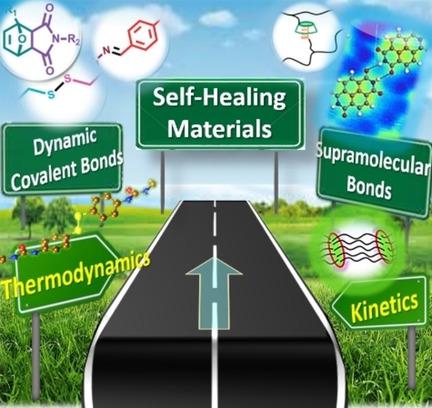当前位置:
X-MOL 学术
›
Chem. Asian J.
›
论文详情
Our official English website, www.x-mol.net, welcomes your
feedback! (Note: you will need to create a separate account there.)
Design Principles of Interfacial Dynamic Bonds in Self‐Healing Materials: What are the Parameters?
Chemistry - An Asian Journal ( IF 3.5 ) Pub Date : 2020-11-02 , DOI: 10.1002/asia.202001157 Mohammad Abdul Sattar 1, 2 , Archita Patnaik 1
Chemistry - An Asian Journal ( IF 3.5 ) Pub Date : 2020-11-02 , DOI: 10.1002/asia.202001157 Mohammad Abdul Sattar 1, 2 , Archita Patnaik 1
Affiliation

|
Polymers and polymer nanocomposites (PNCs) are extensively used in daily life. However, the growing requirement of advanced PNCs laid persistent environmental issues due to deformation‐induced damage that once formed, does not vanish at future stages. Therefore, self‐healing materials with significantly enhanced long life and safety have been designed to epitomize the forefront of recent advances in materials chemistry and engineering. Self‐healing PNC (SH‐PNCs) materials are a class of smart composites in which nanoparticles induce interfacial reconstruction via multiple covalent and non‐covalent interactions culminating in improved mechanical strength and self‐healing capability. However, since the filler nanoparticles are independent of the reversible supramolecular network, the filler incorporation destroys the self‐healing ability but could enhance the mechanical strength. Hence, the molecular parameters controlling the alliance of robust mechanical strength with virtuous self‐healing ability is a crucial challenge. Herein, we review the latest developments that have been made in self‐healing materials and puts advancing insights into the fabrication of SH‐PNCs in which the combination of covalent bonds and non‐covalent interactions provides an optimal balance between their mechanical performance and self‐healing capability. We highlight the importance of specific entropic, enthalpic changes, polymer chain conformations and flexibility that enable the reconstruction of damaged surface and physical reshuffling of dynamic bonds at the interface of cut surfaces.
中文翻译:

自修复材料界面动态结合的设计原理:参数是什么?
聚合物和聚合物纳米复合材料(PNC)在日常生活中被广泛使用。但是,对先进PNC的需求不断增长,由于变形诱发的损害一旦形成就不会在以后的阶段中消失,从而造成了持久的环境问题。因此,旨在显着提高使用寿命和安全性的自愈材料已被设计为体现材料化学和工程学最新进展的最前沿。自修复PNC(SH-PNCs)材料是一类智能复合材料,其中纳米颗粒通过多种共价和非共价相互作用诱导界面重构,最终提高了机械强度和自修复能力。但是,由于填料纳米粒子独立于可逆超分子网络,填料的加入会破坏自愈能力,但会提高机械强度。因此,控制强大的机械强度与良好的自我修复能力的联盟的分子参数是一个关键的挑战。本文中,我们回顾了自愈材料的最新发展,并为SH-PNC的制造提供了深入的见解,其中共价键和非共价相互作用的结合可在其机械性能和自我修复之间实现最佳平衡。治愈能力。我们强调了特定的熵变,焓变,聚合物链构象和柔韧性的重要性,这些变化使受损表面的重建和切割表面界面处的动态键的物理改组成为可能。控制强大的机械强度与良好的自我修复能力的联盟的分子参数是一个关键的挑战。本文中,我们回顾了自愈材料的最新发展,并为SH-PNC的制造提供了深入的见解,其中共价键和非共价相互作用的结合可在其机械性能和自我修复之间实现最佳平衡。治愈能力。我们强调了特定的熵,焓变,聚合物链构象和柔性的重要性,这些特性使受损表面的重建和切割表面界面处的动态键的物理改组成为可能。控制强大的机械强度与良好的自我修复能力的联盟的分子参数是一个关键的挑战。本文中,我们回顾了自愈材料的最新发展,并为SH-PNC的制造提供了深入的见解,其中共价键和非共价相互作用的结合可在其机械性能和自我修复之间实现最佳平衡。治愈能力。我们强调了特定的熵,焓变,聚合物链构象和柔性的重要性,这些特性使受损表面的重建和切割表面界面处的动态键的物理改组成为可能。我们回顾了自我修复材料的最新发展,并为SH-PNC的制造提供了深入的见解,其中共价键和非共价相互作用的结合在其机械性能和自我修复能力之间实现了最佳平衡。 。我们强调了特定的熵,焓变,聚合物链构象和柔性的重要性,这些特性使受损表面的重建和切面界面处动态键的物理改组成为可能。我们回顾了自我修复材料的最新发展,并为SH-PNC的制造提供了深入的见解,其中共价键和非共价相互作用的结合在其机械性能和自我修复能力之间实现了最佳平衡。 。我们强调了特定的熵,焓变,聚合物链构象和柔性的重要性,这些特性使受损表面的重建和切面界面处动态键的物理改组成为可能。
更新日期:2020-12-16
中文翻译:

自修复材料界面动态结合的设计原理:参数是什么?
聚合物和聚合物纳米复合材料(PNC)在日常生活中被广泛使用。但是,对先进PNC的需求不断增长,由于变形诱发的损害一旦形成就不会在以后的阶段中消失,从而造成了持久的环境问题。因此,旨在显着提高使用寿命和安全性的自愈材料已被设计为体现材料化学和工程学最新进展的最前沿。自修复PNC(SH-PNCs)材料是一类智能复合材料,其中纳米颗粒通过多种共价和非共价相互作用诱导界面重构,最终提高了机械强度和自修复能力。但是,由于填料纳米粒子独立于可逆超分子网络,填料的加入会破坏自愈能力,但会提高机械强度。因此,控制强大的机械强度与良好的自我修复能力的联盟的分子参数是一个关键的挑战。本文中,我们回顾了自愈材料的最新发展,并为SH-PNC的制造提供了深入的见解,其中共价键和非共价相互作用的结合可在其机械性能和自我修复之间实现最佳平衡。治愈能力。我们强调了特定的熵变,焓变,聚合物链构象和柔韧性的重要性,这些变化使受损表面的重建和切割表面界面处的动态键的物理改组成为可能。控制强大的机械强度与良好的自我修复能力的联盟的分子参数是一个关键的挑战。本文中,我们回顾了自愈材料的最新发展,并为SH-PNC的制造提供了深入的见解,其中共价键和非共价相互作用的结合可在其机械性能和自我修复之间实现最佳平衡。治愈能力。我们强调了特定的熵,焓变,聚合物链构象和柔性的重要性,这些特性使受损表面的重建和切割表面界面处的动态键的物理改组成为可能。控制强大的机械强度与良好的自我修复能力的联盟的分子参数是一个关键的挑战。本文中,我们回顾了自愈材料的最新发展,并为SH-PNC的制造提供了深入的见解,其中共价键和非共价相互作用的结合可在其机械性能和自我修复之间实现最佳平衡。治愈能力。我们强调了特定的熵,焓变,聚合物链构象和柔性的重要性,这些特性使受损表面的重建和切割表面界面处的动态键的物理改组成为可能。我们回顾了自我修复材料的最新发展,并为SH-PNC的制造提供了深入的见解,其中共价键和非共价相互作用的结合在其机械性能和自我修复能力之间实现了最佳平衡。 。我们强调了特定的熵,焓变,聚合物链构象和柔性的重要性,这些特性使受损表面的重建和切面界面处动态键的物理改组成为可能。我们回顾了自我修复材料的最新发展,并为SH-PNC的制造提供了深入的见解,其中共价键和非共价相互作用的结合在其机械性能和自我修复能力之间实现了最佳平衡。 。我们强调了特定的熵,焓变,聚合物链构象和柔性的重要性,这些特性使受损表面的重建和切面界面处动态键的物理改组成为可能。











































 京公网安备 11010802027423号
京公网安备 11010802027423号